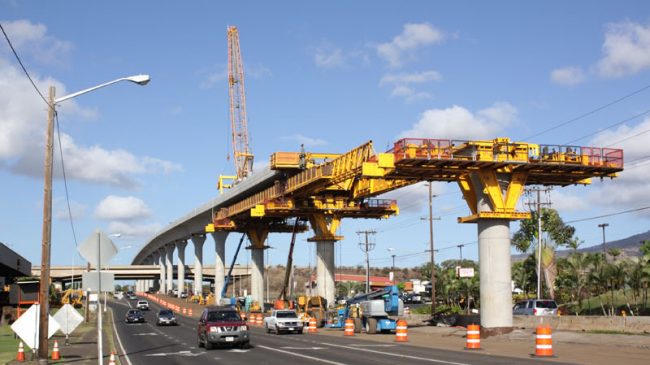Washington, DC, is being flooded with long wish lists of transportation infrastructure projects, as interested parties hope for a gusher of new federal dollars for this purpose. Such a gusher is highly unlikely, for which we should actually be thankful, because funding projects whose outputs are worth less than their inputs makes a country poorer.
To get a handle on where investment would be productive, we first need to review the data. On highways and bridges, two new reports provide some clues. The Department of Transportation’s Bureau of Transportation Statistics (BTS) recently released its Transportation Statistics Annual Report 2016. On bridges, it provides the welcome news that the fraction of structurally deficient bridges on US highways was reduced 37 percent between 2000 and 2015 to a new low of just 9.6 percent. Much less progress has been made on functionally obsolete bridges, which were reduced only 12 percent over that same 15-year period, and now represent 13.7 percent of all bridges.
On highway condition, BTS reports only minor changes in the percentage of highway miles in poor condition between 2000 and 2014, but the good news from DOT’s 2015 Status of the Nation’s Highways, Bridges and Transit: Conditions & Performance was that overall 80.3 percent of federal-aid highways were in “acceptable” condition as of 2012 (the last year covered in the Conditions & Performance report), and when weighted by vehicle miles travelled (VMT), that number is 83.3 percent.
These data make it pretty clear that America’s highway and bridge infrastructure is not “crumbling,” and there is no need for a massive program on that score. Far more troubling is that urban traffic congestion is soaring again as vehicle miles of travel have rebounded since the Great Recession. The recently-released INRIX Global Congestion Ranking puts Los Angeles in first place as the world’s most congested metro area. It also estimates traffic congestion cost US drivers nearly $300 billion in 2016. That’s almost double the $160 billion estimate from Texas A&M Transportation Institute’s most recent report, two years ago.
These findings suggest that a better target for large-scale transportation investment is major metropolitan area megaprojects such, as networks of express toll lanes, rather than an overall focus on “crumbling” highways and bridges. But even here, wish lists are a poor tool for deciding which projects to pursue. For that, the bare minimum is an objective cost-benefit analysis carried out at arm’s-length from project promoters. It must document realistic benefits (such as travel-time savings) and use realistic estimates of total construction costs.
To illustrate the difference between wish lists and a cost-benefit-screened investment program, take a look at the investment gap for highways and transit in the American Society of Civil Engineers (ASCE) 2016 report card on U.S. infrastructure. Over the next 10 years, ASCE claims a need for an additional $110 billion per year. By contrast, the Conditions & Performance report’s scenarios for improved highway and transit conditions and performance use FHWA and FTA B/C-based models to estimate productive investments. The Federal Highway Administration’s (FHWA’s) gap for highways and bridges is $37.3 billion per year and the Federal Transit Administration’s (FTA’s) gap for transit projects is $5.8 billion per year, so the total is $43.1 billion per year. That’s hardly chicken feed, but it’s only 39 percent of ASCE’s $110 billion per year estimate. ASCE’s number is based on a wish-list approach of doing all the projects that sound good to engineers, regardless of whether their costs are greater than their benefits.
Most of the wish-lists being shopped around DC provide estimates of the jobs that would be created by all these would-be construction projects. That’s bogus for three reasons. First, those are only temporary jobs, and if that’s why you’re doing the projects, there could be just as many jobs building pyramids or paying people to dig holes and fill them up again.
Second, we are not in a recession. Most economists estimate that our economy is just about at “full employment” these days. That means there is not a reserve army of unemployed heavy-equipment operators, ironworkers, carpenters, etc. needing massive numbers of construction jobs.
And third, the real justification for improving transportation infrastructure is to make our economy more productive. Transportation infrastructure is not the end we should be aiming at; it’s the means to the end of faster and more reliable goods movement, shorter and less stressful commutes, and better matching of employer needs and employee skills thanks to increased access to the best job matches.
For all these reasons, any new federal effort to improve transportation infrastructure should focus mainly on increasing the use of public-private partnership (P3) concessions, for which cost-benefit analysis and ‘value for money’ assessments are standard practice. That will require three key reforms. First, increase access to innovative finance, by removing the cap on tax-exempt Private Activity Bonds and preferably expanding their use to water and air transportation infrastructure, while expanding and streamlining the Transportation Infrastructure Finance and Innovation Act (TIFIA) program. Second, remove an array of federal barriers to P3 projects, as I outlined in last month’s column. And third, implement across-the-board reforms to the convoluted and time-consuming review processes that large projects must go through to be green-lighted for procurement. Last month’s Public Works Financing summarized a menu of such changes.
In short, most of America’s infrastructure is not crumbling, but its performance—especially that of urban highways—is a major drag on the productivity of our economy. Pumping a trillion dollars willy-nilly into infrastructure risks wasting large fractions on projects that would subtract value from our economy. Shifting as much infrastructure investment as possible to public-private partnership concessions is the best way to ensure productive investment in these vital facilities.
This column first appeared in Public Works Financing.

